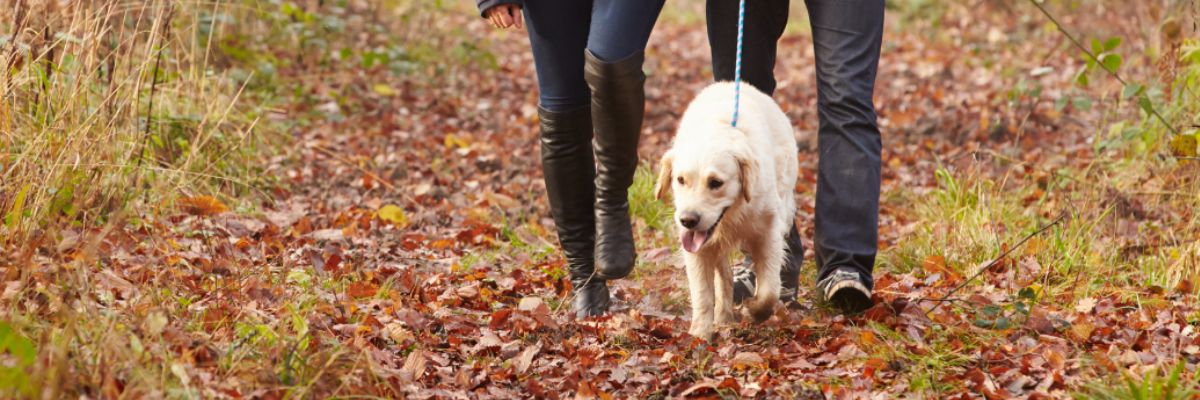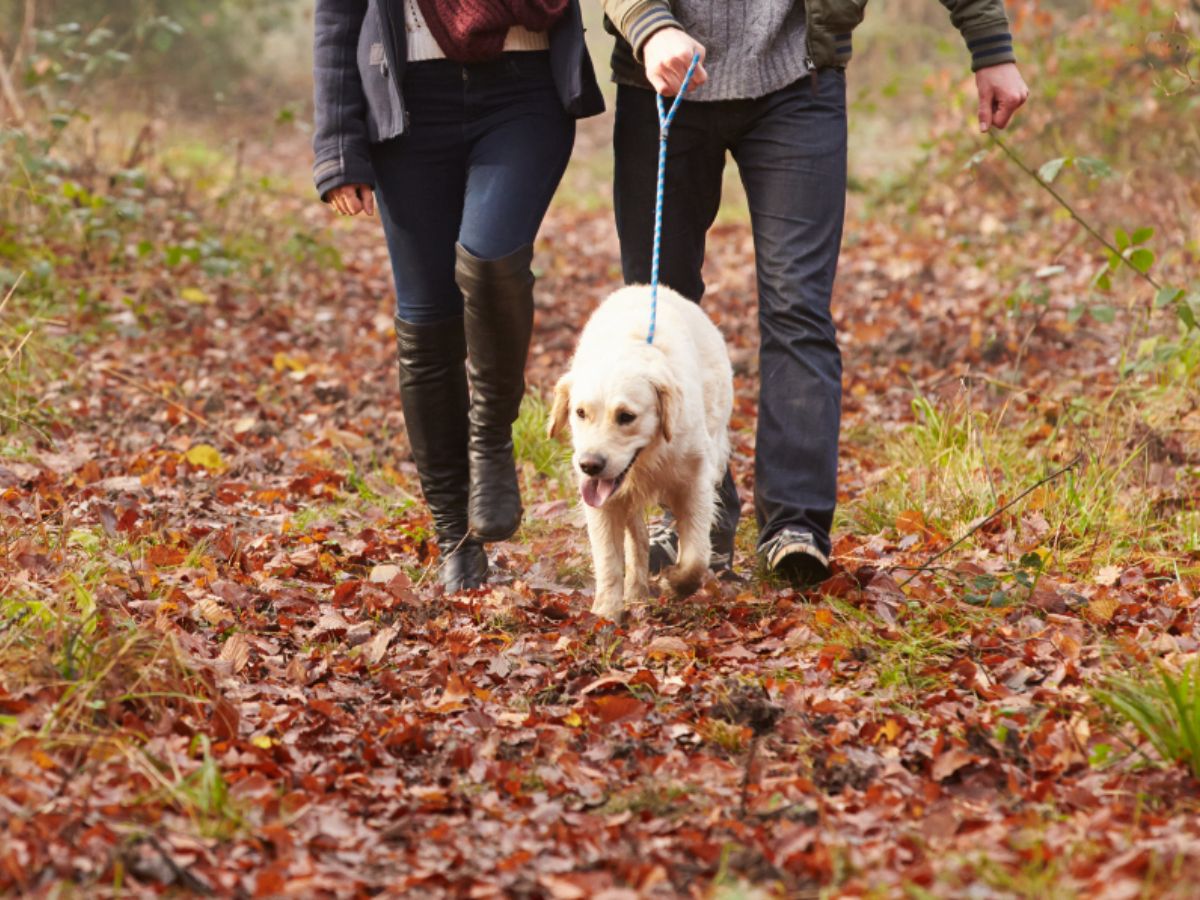Do you need help?

Autumn is a wonderful time of year that brings crisp leaves, golden walks and cosy evenings. But as we get to enjoy the seasonal changes, it’s important to stay aware and vigilant for our pets. With new smells and textures to explore, autumn brings a variety of hidden dangers for dogs, both outdoors and at home.
To help keep your dog safe this season, we’ve rounded up the top 9 autumn hazards to watch out for.
1. Harvest mites
Harvest mites (Neotrombicula autumnalis) are microscopic arachnids that live in long grass and woodland areas. These tiny insects will climb up long grass, bushes and sit waiting to attach themselves to any warm-blooded creatures that stroll by.
You might notice clumps of small, orange bugs on your dog, so it’s best to incorporate regular grooming after walks to help spot these pests early. Signs of harvest mites on your dog can include the skin being itchy and inflamed. To help prevent the mites attaching to your dog out and about, you can treat them with a preventative fipronil-based spray before you head out for walks in wooded areas.
2. Mushrooms and toadstools
With thousands of species of mushrooms in the UK, this means that identifying non-toxic and toxic mushrooms is extremely difficult. The safest approach is to assume all wild mushrooms could be harmful and to keep your dog well away from them during Autumn walks.
If ingested, toxic mushrooms can lead to serious health issues, including liver and kidney failure. Some species are even neurotoxic, which can affect your dog’s nervous system and result in disorientation, unsteady movement, or seizures.
A helpful way to remember the common signs of mushroom toxicity is through the acronym SLUDGE:
- Salivation – excessive drooling
- Lacrimation – increased tear production
- Urination – due to the relaxation of the bladder
- Defaecation – often diarrhoea
- Gastrointestinal distress – cramps and pain
- Emesis – vomiting
If you spot any of these signs or suspect your dog has eaten any wild mushrooms, contact your vet or if out-of-hours, your nearest Vets Now
3. Fireworks
Despite being an integral part of many celebrations throughout the year, fireworks cause an overwhelming and frightening experience for many dogs. The loud bangs and bright flashes often trigger anxiety, causing dogs to become startled, agitated, or even physically ill.
One of the biggest concerns during autumn and the darker months is that a frightened dog may panic and run, potentially into dangerous roads or poorly lit areas, putting them at serious risk. Here’s how to keep your dog calm during firework season:
- Create a Safe Retreat
Designate a quiet, cosy area where your dog can feel secure. This could be a quiet room or a den-like space with a comfy bed, familiar toys, and your dog’s favourite blanket. Familiar scents and items can be incredibly soothing.
- Use Sound to Mask the Noise
Playing calming music, white noise, or a TV show with background sounds can help drown out the sudden bangs.
To help, we have created a soothing Spotify playlist especially for dogs to help reduce stress during firework displays:
- Check ID and Microchip Details
Make sure your dog’s microchip and ID tag details are up-to-date. In the unfortunate event that they do escape, this greatly increases the chances of a safe and speedy return.
- Stay Close and Reassuring
Your presence is often the best comfort. Speak calmly, stroke gently, and simply stay nearby. Even if your dog is hiding, knowing you’re there can offer reassurance.

4. Darker nights
As the days grow shorter and the dark nights creep in earlier, a big concern during Autumn is reduced visibility on dog walks, of which many will inevitably happen in low light or complete darkness. Unfortunately, a dog that is harder to see is at higher risk of accidents, especially near roads, busy parks or woodland areas.
To help protect both yourself and your dog during the darker evenings, the following are important to consider:
Reflective collars and leads: These bounce back light from headlights and torches, making your dog more noticeable.
LED collar lights: Clip-on lights or glow collars are a simple way to make your dog stand out in the dark.
Hi-Viz jackets or vests: Bright, reflective clothing is especially helpful for dogs with a darker coat who can easily blend into the dark.
5. Rock salt
Rock salt (sodium chloride) is often used for de-icing roads and pavements. It can be an irritant where the sharp, gritty crystals can scratch paw pads, causing dryness, cracking, or abrasions.
If ingested, it can cause your dog to become dehydrated or in serious cases, cause liver failure if they lick it from their paws. Ensure that you wipe your dog’s paws thoroughly to remove any rock salt after you have taken them on a walk.
6. Acorns and conkers
Two common sights on the ground throughout Autumn are acorns and conkers. Although seemingly harmless, they can pose serious risk to curious dogs who like to sniff and chew the things they discover out on their walks.
Conkers (the seeds of the horse chestnut tree) contain poison called aesculin which can cause drooling, vomiting, diarrhoea and abdominal pain. Ingestion can also lead to potentially fatal intestinal blockages.
Acorns (the nuts of an oak tree) contain a chemical called gallotannin that is toxic to dogs where ingestion can cause liver and kidney damage. Acorns are also hard and sharp and can cause an internal obstruction if ingested. Affected dogs will show signs that include vomiting, diarrhoea, lethargy and abdominal pain.
If you notice signs or suspect your dog has ingested an acorn or conker, contact your vet.
7. Halloween treats
Although chocolate and sweets are an important part of Halloween for humans, they should be kept well out of your dog’s reach.
Chocolate contains a chemical called theobromine, which is toxic to dogs and mainly affects the guts, heart, central nervous system, and kidneys. Meanwhile, jelly sweets contain an artificial sweetener called xylitol, which is also poisonous to dogs.
Make sure to store all sweets and chocolate well out of reach from curious noses, and remind any children or guests to not share their treats with your dog.
8. Rat poison
Rodenticide is commonly put down in Autumn when rats start heading indoors for warmth. The chemicals used in these products are often highly toxic to dogs and cause internal bleeding, kidney failure, organ damage – and in very serious cases, can be fatal.
It’s extremely important to act fast if you suspect your dog has ingested rat poison. Contact your vet or if out-of-hours, your nearest Vets Now (Emergency Vet Near Me | 60+ Out-of-hours Vet Clinics & Hospitals)
9. Antifreeze
Antifreeze poisoning in dogs typically occur when ethylene glycol, one of the main ingredients in antifreeze, leaks from car radiators or screen wash containers.
This chemical is very sweet-tasting and palatable, however is extremely toxic to dogs. The main signs to look out for are:
- Vomiting
- Feeling thirsty
- Seizures
- Lack of appetite
- Difficulty breathing
The antidote for antifreeze poisoning is effective when administered within the first 8-12 hours of ingestion – so it important to act as soon as possible.
Stay safe this autumn
For easy reference, download our handy infographic to keep these autumn hazards top of mind and help protect your dog all season long.

